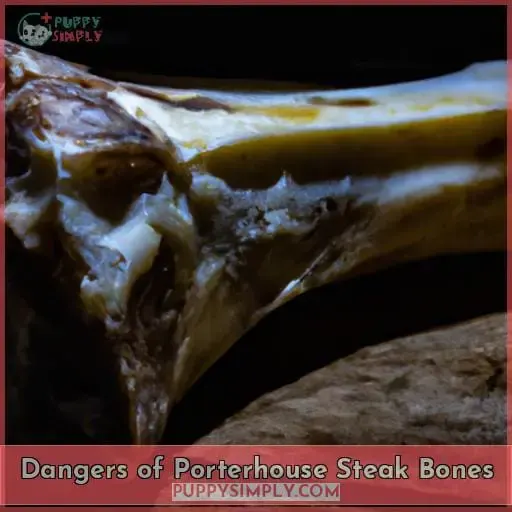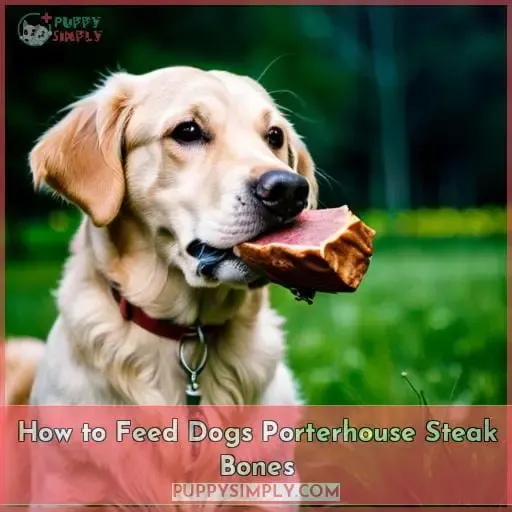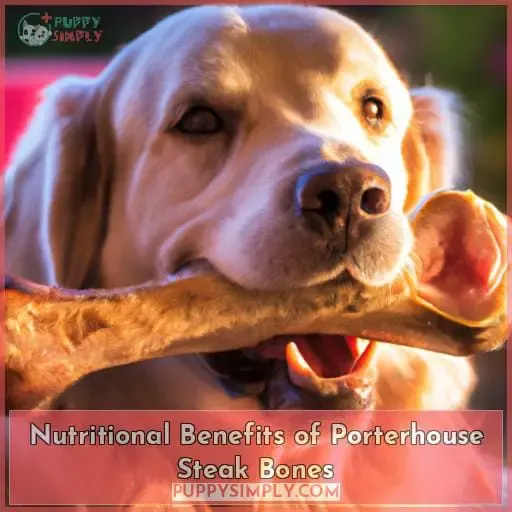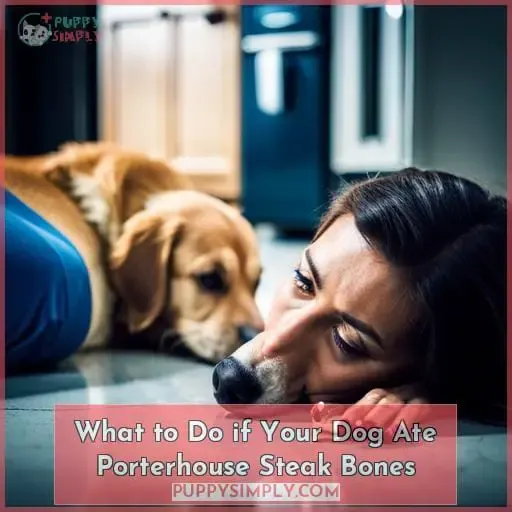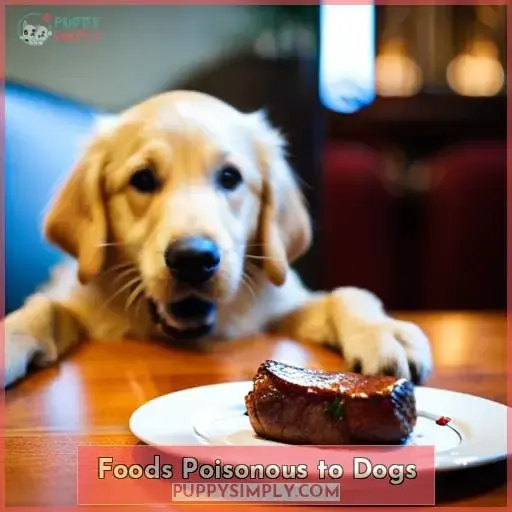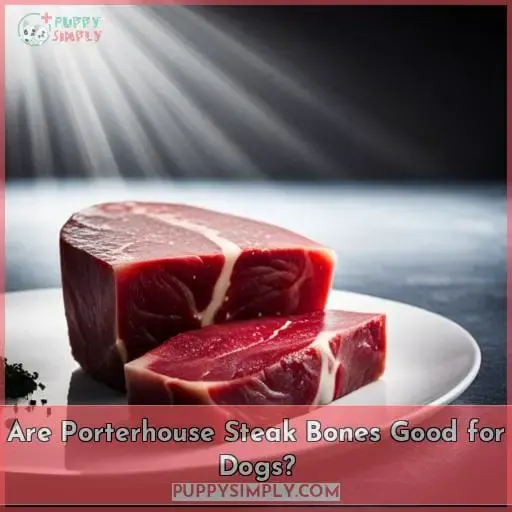This site is supported by our readers. We may earn a commission, at no cost to you, if you purchase through links.

The risks associated with these types of hard cooked or raw beef ribs extend far beyond choking hazards and include potential damage to teeth, throat, stomachs, and bowels due to splintering shards.
In this article, we will discuss why feeding dogs porterhouse steak may cause more harm than good. We will also explore safety tips on how owners can feed their pooches responsibly if they choose to.
Table Of Contents
- Key Takeaways
- Can Dogs Eat Porterhouse Steak Bones?
- Safety Tips for Giving Dogs Bones
- Dangers of Porterhouse Steak Bones
- How to Feed Dogs Porterhouse Steak Bones
- Nutritional Benefits of Porterhouse Steak Bones
- What to Do if Your Dog Ate Porterhouse Steak Bones
- Foods Poisonous to Dogs
- Are Porterhouse Steak Bones Good for Dogs?
- Raw Vs. Cooked Porterhouse Steak Bones
- Frequently Asked Questions (FAQs)
- Conclusion
Key Takeaways
- Porterhouse bones can splinter and cause internal injuries or blockages.
- Raw bones pose a risk of bacterial contamination.
- The high fat content in porterhouse bones can cause pancreatitis.
- The shape and size of porterhouse bones pose choking hazards.
Can Dogs Eat Porterhouse Steak Bones?
It’s important to understand the risks of feeding your pup porterhouse steak bones, as they can be more brittle than raw bones and may splinter if chewed. Domesticated dogs have been eating meat for thousands of years, however, it is still essential to consider what could happen when offering them cooked animal products such as steak bones.
Raw bone consumption is generally safe for most dogs. However, there are potential health risks associated with cooked meats that contain toxins like onion or garlic, which can be toxic to pets. Feeding your dog a porterhouse steak bone carries certain dangers too since it has high levels of fat content compared to other cuts.
This should only be offered in moderation due to its possibility of leading towards an upset stomach or pancreatitis in some cases.
Additionally, because these types of bones tend to break down into sharper pieces when chewed by our canine companions, owners must take extra precautions and supervise closely while their pup enjoys his treat.
As always, though, if you notice any signs such as vomiting, diarrhea, or lethargy after having consumed one, then contact your vet immediately for further guidance on how best to proceed from here on out!
Safety Tips for Giving Dogs Bones
As a pet owner, it’s important to be aware of the potential risks associated with offering your dog bones. Always supervise bone chewing and consider your pup’s teeth health before giving them something hard to chew on.
Bones should also only be given after meals in order to help reduce the risk of choking. Small bones should always be avoided as they are more likely to splinter or cause internal injury if swallowed.
Once finished with their treat, make sure you throw away any remaining bones so that no further issues can arise from them being ingested again later!
Always Supervise Bone Chewing
Always keep a close eye on your pup when they’re chomping down on bones, as it’s like playing with fire.
No matter the size of your dog – small or large – ensure you monitor them closely for signs of choking, illness, or other distress.
Even if they seem to be enjoying their treat, pay attention to how quickly they chew and whether any pieces break off into smaller parts that could cause sickness if swallowed.
Keep an especially watchful eye out with puppies and food-motivated breeds who might try to swallow bigger chunks than are safe for them!
Monitor their behavior carefully and act fast at even the slightest sign something is wrong: contact a vet immediately should there be any suspicion of danger due to bone consumption.
Be Aware of Your Dog’s Teeth Health
Be mindful of your pup’s dental health when giving them bones. Their teeth can easily be damaged if they are too brittle, jeopardizing their good health.
- Checking for broken teeth in the dog’s mouth
- Monitoring chewing time and intensity
- Refrigerating the bones and then discarding them after a few days
- Making sure the bones aren’t too hard or dry
Avoid unhealthy consequences due to incorrect bone consumption by keeping an eye on your pooch!
Give Bones After Meals
Feeding your pup bones after meals helps to ensure they don’t break their teeth on them, so give them a treat when dinner’s done!
Raw steak bones can provide essential nutrients for a healthy coat and are less likely to splinter than cooked ones. If your dog loves steak bones, make sure the pieces are small enough that they won’t choke or suffer internal injuries.
Cooked steak bones tend to be more brittle and prone to breaking into sharp chunks – watch closely! Provide an alternative if necessary; chew toys, hooves, frozen treats, or peanut butter kongs offer plenty of satisfaction without risk.
Avoid Small Bones
Avoid giving your pup small bones, no matter how appealing they may seem. Steak bones can cause choking or damage to teeth and internal organs if not the right size. Splintered bone shards could lead to serious health consequences such as blockages or bacterial contamination.
- Supervise chewing closely
- Use appropriate-sized pieces
- Discard after a few days in the refrigerator
- Choose safe alternatives like chew toys, hooves, frozen treats, etc.
Throw Them Away
Once your pup is done chewing, it’s time to throw the bones away! Raw bones pose a risk that cooked ones don’t; splintered pieces can turn into small parcels of meat, which could cause serious harm. Dispose of any leftovers for safety reasons, as wild dogs may have strong jaws and teeth, but yours might not be so lucky.
Bones are nourishing but must be handled with care. Limit marrow consumption as this can lead to pancreatitis too. Always throw them away once they’ve served their purpose, whether raw or cooked.
Dangers of Porterhouse Steak Bones
It is important to be aware of the potential risks when considering offering your dog steak bones, such as cooked or raw porterhouse. These can bring about dangers from parasites and toxic seasoning, as well as a risk of choking due to their size and shape.
It is therefore essential that you understand the possible consequences before introducing any type of bone into your pet’s diet.
Cooked Steak Bones
When it comes to cooked steak bones, you need to be careful as they can become brittle and easily splinter when chewed. The fat content of these types of bones is much higher than raw ones, which poses a danger for choking.
Although there are some nutritional benefits associated with them, caution must be taken due to the potential health risks involved in feeding dogs steak bones. Make sure that your pet is supervised while consuming such treats and provide other alternatives if any signs of distress occur during or after eating them.
Raw Steak Bones
Be aware that while raw steak bones may seem like a good idea, they can be just as dangerous as cooked ones due to the risk of splintering and bacterial contamination. Dog owners should bear in mind that these types of bones are not safe for their pets to consume.
The fat content is also higher than other dog foods, which can pose choking risks if chewed incorrectly. Additionally, providing excellent dental health benefits isn’t worth the danger associated with consuming such treats either, so seek alternative options when looking for ways to treat your pet safely and effectively.
Parasites
Additionally, consuming porterhouse steak bones can also pose a risk of parasites for your pet. Dog experts warn that domestic dogs are particularly vulnerable to the organisms found in raw meat. Therefore, it is advised not to use toxic seasoning on such bones and keep them away from pets altogether.
Steak bones should be avoided at all costs as they may contain dangerous levels of bacteria or parasites, which can cause severe health issues if ingested by your canine companion.
Toxic Seasoning
It is important to note that porterhouse steak bones should never be seasoned with onions, garlic, herbs, or pepper as they can be toxic for your furry pal. Steak meat contains a high fat content, and cooked bone can break into small pieces, which are dangerous when added to a dog’s diet.
Ensure no seasoning has been used before giving it to your pet and always supervise while they consume it.
Danger of Choking
Take caution when giving your pup a porterhouse steak bone. Brittle pieces can easily become lodged in their throat and cause choking. The high-fat content makes it unsuitable for good cholesterol levels, while strong chewers may be at risk of digestive obstruction.
How to Feed Dogs Porterhouse Steak Bones
Once you understand the risks of feeding your dog porterhouse steak bones, it’s important to know the proper way to do so. Porterhouse steak bones can be an excellent addition to a dog’s diet as they provide essential vitamins and minerals that are beneficial for their health.
Dogs have some of the strongest jaws in animals, which allows them to break down most types of raw steak bones with ease.
Here are key points on how to feed dogs porterhouse steak bones:
- Always supervise while eating.
- Allow for chewing time and remove after a few days.
- Refrigerate or freeze before giving.
- Avoid toxic seasonings like onions, garlic, and pepper when preparing meals.
It is also best practice not to give too much marrow, as this could cause vomiting or diarrhea due to digestive issues such as pancreatitis. So ensure moderation if you decide to offer your pup any type of raw bone from beef ribeye steaks, filet mignon, T-bone, etc.
In order to keep both safe from harm, make sure chew toys are available as alternate forms of entertainment along with providing a regular exercise routine!
Nutritional Benefits of Porterhouse Steak Bones
Greeting! It is important to note that porterhouse steak bones can be a nutritious and beneficial addition to your dog’s diet. Along with their calcium and phosphorus content, these types of bones also contain minerals, vitamins, connective tissue, as well as small parcels of meat attached to them.
Moreover, the rich marrow inside offers an additional source of nutrition for our canine friends.
Minerals and Vitamins in Bones
You can reap the nutritional benefits of porterhouse steak bones while keeping your pup safe by offering them in moderation and with proper precautions. Bones are a good source of calcium, phosphorus, protein, and other essential minerals that help keep teeth strong and provide vitamins for a healthy dog’s diet.
Marrow, which contains polyunsaturated fats, also aids digestion when consumed at room temperature. It is important to keep an eye on your pet during consumption as chewing too vigorously or swallowing bones could damage brittle teeth, leading to internal injuries or blockages.
Connective Tissue and Small Parcels of Meat Attached to Bones
Be sure to keep an eye on your pup as they chomp away, as there are often small parcels of meat and connective tissue that can break off from the bone. These pieces contain healthy fat, which is important for breed health risks, but could also lead to the buildup of bacteria in a dog’s muzzle or signs of gum disease.
- Monitor chew time
- Never leave bones unsupervised
- Refrigerate, then discard after a few days
Rich Marrow Inside Bones
Enjoy the rich marrow inside bones, but limit consumption as it can cause vomiting and diarrhea. Raw steak bones are an excellent source of protein with a high fat content, making them one of the best-looking bones on your pup’s plate.
However, they must be supervised at all times to avoid damage to your dog’s muzzle or gum disease from bacteria buildup due to small pieces that may break off during chewing.
What to Do if Your Dog Ate Porterhouse Steak Bones
If your dog has eaten a porterhouse steak bone, you should take certain precautions. First, inspect the area around your dog’s muzzle to ensure that no large pieces of bone have become lodged in their throat or mouth.
If everything looks normal and there are no signs of choking or distress, then it’s important to monitor them closely for any potential complications on an ongoing basis.
Additionally, it’s advisable to consider changing up their diet by providing a better option than bones. However, if they must be given as treats, make sure they are supervised while eating and chew thoroughly in case aggressive chewing occurs, which can lead to serious problems with digestion or blockage further down the line.
As long as regular check-ups at the vet provide a clean bill of health after consuming these types of bones, your pup will be just fine!
Foods Poisonous to Dogs
It is important to be aware of the potential dangers posed by foods toxic to dogs. Garlic and onions, grapes, chocolate, macadamia nuts, black walnuts, nutmeg, as well as alcohol can cause serious harm if ingested by your canine friend.
Knowing which foods are potentially dangerous for your dog should help you avoid any future health complications that could arise from consumption of these items. It is therefore critical to ensure that all food given or available in the home environment does not contain any of these ingredients or products.
Garlic and Onions
It’s important to never feed your pup garlic or onion, as these seasonings are toxic for dogs and can cause potentially dangerous health risks.
Check the area around your dog’s muzzle before giving them yummy meat such as beef bones or porterhouse steak bones – if they have a green light, still monitor closely!
Bones can splinter easily and lead to choking hazards which should be avoided at all costs.
Keep an eye out for any signs of distress like vomiting, diarrhea, lethargy, or bloody stools that could indicate trouble.
If you see these symptoms, contact the vet immediately – it’s not worth waiting until further complications arise from consuming onions and garlic!
Grapes
Be sure to keep grapes away from your pup – even a small amount can cause serious health risks! Grapes contain fatty acids that can damage the digestive system. If you’re unsure, check with your vet first considering their medical history and the nutritional benefits of feeding porterhouse steak bones.
Choking on these foods is also dangerous, so always monitor closely if giving them treats like this.
Chocolate
Chocolate can be a serious health risk for your pup, so always keep it away! It contains fatty acids that cause digestive harm and can lead to expensive vet bills. Also, choking is possible if not monitored closely. Plus, theobromine in chocolate causes internal damage and affects healthy skin negatively.
Macadamia Nuts, Black Walnuts, and Nutmeg
Be mindful of macadamia nuts, black walnuts, and nutmeg – they can be dangerous for your pup. Have you ever seen the effects these foods have on a pet? Fatty acids lower bad cholesterol, but there’s no definitive answer about the nutritional benefits or dangers of steak bones.
The general consensus is to avoid them as splinters could cause internal damage when ingested by dogs.
Alcohol
Alcohol should never be given to pets as it can cause serious health issues and even be fatal. Make an informed decision about the kind of steak bones to feed your pet, considering nutritional benefits and dangers.
Steak bones may splinter easily, making them hard for a dog to maneuver while eating – potentially causing internal damage if ingested.
Are Porterhouse Steak Bones Good for Dogs?
It is important to consider the nutritional benefits and health risks when deciding if porterhouse steak bones are a safe option for your pet. Many people believe that raw steak bones can provide essential nutrients in their dog’s diet, such as calcium, phosphorus, and lots of omega-3 fatty acids.
However, before feeding them to your dog, it’s essential to make sure they don’t contain any hidden toxins or have been cooked improperly, leading to splintering which could cause choking hazards or internal injuries.
If you choose this route, it’s advised that you seek advice from a veterinarian who can help determine whether these types of bones will be suitable for your pup following thorough examinations. The Chicago Steak Company has made a commitment through its blog posts on canine nutrition regarding the safety of raw steak bone consumption by dogs.
However, caution should still be taken even with this type of recommendation as there are potential risks associated with ingestion due to size and texture differences between breeds, along with other factors like age, etc.
In summary, while some organizations may suggest feeding certain types of raw meaty bone products under controlled conditions only after consulting an expert, doing so would come at risk. So, exercise caution whenever considering adding anything new into your pet’s existing diet plan.
Raw Vs. Cooked Porterhouse Steak Bones
If you’re considering adding porterhouse steak bones to your dog’s diet, it’s important to understand the difference between raw and cooked versions.
Raw steak bones are generally considered more digestible than their cooked counterparts due to a lower fat content. This can help reduce the risk of digestive issues such as vomiting or diarrhea in some dogs.
However, raw bones also pose an increased risk of bacterial contamination, which could cause illness if not properly handled and refrigerated after feeding.
Cooked pork or beef ribs may be safer for most dogs since they tend to splinter less easily when chewed on compared with their uncooked counterparts.
When selecting either type of steak bone for our canine companions, it’s best practice to seek advice from a veterinarian first. They can help determine whether these types will be suitable based on breed size and age differences amongst other factors before introducing them into your pup’s daily nutrition plan.
Frequently Asked Questions (FAQs)
How often should I give my dog Porterhouse steak bones?
Offer your pup Porterhouse steak bones sparingly; no more than once a week. Not only do these delicious treats pose health risks, but they can also lead to unhelpful habits if given too often.
Are Porterhouse steak bones recommended for small dogs?
While Porterhouse steak bones are not recommended for small dogs due to their size and density, you can closely supervise and break the bone into smaller pieces. Refrigerate after feeding time, then discard after a few days. Monitor your pup’s health carefully for signs of trouble.
What is the best way to store Porterhouse steak bones?
Store Porterhouse steak bones safely in a sealed container or bag, out of reach from your pet. Refrigerate and discard any unused portions after several days to avoid bacterial contamination.
Are there any alternatives to giving my dog Porterhouse steak bones?
Yes, there are alternatives to giving your dog Porterhouse steak bones. Look into chew toys, hooves, frozen treats, or peanut butter kongs that can give them the same nutritional benefits as cooked bones but without the risk of splintering and choking hazards.
What is the best way to dispose of used Porterhouse steak bones?
Dispose of used Porterhouse steak bones properly by refrigerating them first, then discarding them in a sealed trash can.
Conclusion
In a nutshell, the question of whether or not dogs can eat porterhouse steak bones is complex and should be approached with caution. Bones, whether raw or cooked, can splinter and cause choking. Additionally, dogs shouldn’t eat bones that have been seasoned with toxic ingredients like onion or garlic.
While some bones, like porterhouse steak bones, do have nutritional benefits, such as minerals and vitamins, there are still risks associated with feeding them to dogs. It’s important to always supervise your dog when it’s eating bones and to contact your vet if you suspect that your dog may have ingested a bone or is showing signs of distress.


